Only six percent of U.S. adults don’t know how to ride a bicycle, according to a 2013 survey by YouGov, and I am one of them.
They say you never forget, but they’re wrong because I did. After learning to ride a bike when I was 8, I wheeled around on trails for a few years before conclusively quitting.
More than a decade later, in New York City's busy Central Park, I had the horrid idea to get back on a bike. I swerved and fell. A preteen boy pointed and laughed. That was the last ride of my adult life.
But what about those electric scooters, which Chicago recently rolled out as part of a four-month pilot program? Like bicycles, they're meant to be ridden in the street, through Chicago's terrifying traffic patterns.
To their credit, dockless scooters are both energy efficient and convenient. A December study by DePaul found that e-scooters would make about 16 percent more jobs in the Loop accessible within 30 minutes compared with public transit or walking. In the first week of Chicago’s pilot program, people took more than 60,000 scooter rides, according to the city's Department of Business Affairs and Consumer Protection (BACP).
Still, most people I’ve spoken to anecdotally are scared of getting hurt on the scooters. Their fears aren't unwarranted: On June 19, four days into the pilot program, rider Mary Fraction broke her wrist while scooting on a city sidewalk. The next day, cyclist Allyson Medeiros was hit by a scooterer riding the wrong way in the bike lane, Block Club Chicago reported. He was hospitalized with fractured facial bones, four broken teeth, a broken nose, and cuts that required more than 20 stitches. (Medeiros has since sued in an attempt to find the rider, who fled the scene.)
Armed with the facts but zero experience, I decided to try a scooter in the West Loop, where the vehicles are as ubiquitous as strollers. At half past five on a Wednesday, I found a Sherpa, one of ten companies vying for a permanent scooter permit in Chicago. I downloaded the app, signed away my legal rights, and strapped on a helmet. (I've yet to see another rider wearing one, but they are required.)
I had two goals for my ride:
- Get the hang of it enough to say I'd done it and would therefore never have to do it again
- Don't injure anybody else, and preferably don't injure myself.
Things did not start well. Scooter riding, it turns out, requires one to both balance and steer at the same time. This was a big commitment for me. My heart thumped every time I hit the gas, and I would jump off — hand brake be damned — whenever I felt I was losing control. I did, however, hang onto the handlebars.
“Who likes this?” I asked my husband, an avid scooter rider whom I'd brought along for pointers, and to call 911 if necessary. He described my initial attempts as “hard on the eye.”
But eventually, I got the hang of it. By about 15 minutes into my 21-minute, 46-second ride, during which I traveled exactly .99 miles, I felt like I could ride a scooter without first checking that there were no moving cars within a block of me.
A rocky start is the norm, too. In an Austin Public Health survey of 125 people with scooter-related injuries, 33 percent said they got hurt during their first ride.
“The City of Chicago is committed to ensuring health and safety throughout this pilot program,” BACP said in a statement. “[We are] working closely with the Chicago Department of Public Health (CDPH) to track injuries and evaluate the impact of scooters on the safety of Chicago residents. CDPH has asked hospitals to report the injuries associated with scooters, allowing CDPH to evaluate injury trends and patterns.”
Turns out, there's dockless scooter training, too. Lime, another of the companies in Chicago’s pilot program, is offering free weekend training courses. If you think you’ll ride like I did in the beginning, I highly recommend it.
As for me: I don’t know that I’ll ever ride a scooter again, but I probably could if I had to. After all, nobody said you never forget how to ride a scooter.



